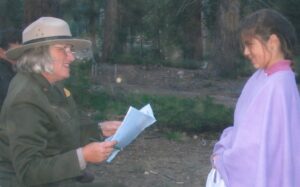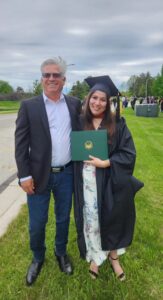Daxton Castellanos, one of the first two students to graduate with a Master of Science in Biodiversity Conservation and Management this spring, realized she wanted to study environmental science late in her undergraduate career, but her counselors advised against changing her major. Instead, they encouraged her to finish her degree and then apply for a graduate program based in environmental science.
Her passion for the environment is rooted in travel experiences she’s had over the years, particularly in her home state of California.
“I just really enjoy nature itself,” she says. “I grew up being very adventurous with my family. We did a lot of trips within California, to Yosemite, Sequoia, and a lot of the national parks.”

Daxton, who graduated from UC Santa Barbara in 2018 with a bachelor’s degree in International and Global Studies and a minor in German, also studied abroad in Berlin for one year.
“A lot of the classes I took [for my major] overlapped with environmental studies,” she adds. “And then I studied abroad as well, and so I learned about different international and environmental policies.”
After graduation, she moved back to her hometown of Bakersfield, Calif.
“Since I didn’t have any environmental science experience, I actually became an environmental health technician in Kern County,” she says. “As an environmental health technician, I started in the water program. I helped with pool inspections. I did all the pools in Kern County; that’s about 900 pools and spas.”
One year later, she moved to the Consumer Protection Program, where she completed tobacco, hotel and motel inspections. Then, she moved to the food program, where she was involved with permitting public events hosting food vendors. While working for the Mobile Food Program, which requires every food truck to renew their permit annually, she helped create online portals in English and Spanish to streamline the approval process. She was also the point of contact for two major events: the Kern County Fair and Lightning in a Bottle, a music festival.
“It was really fun, but it was a lot of work,” she says. “In one month, you could have 30 events. And of course, they’re usually all focused on the weekend. And you can have two to 50 vendors, and you have to get them all permitted.”
After getting some solid work experience, she began searching for graduate-level science programs. In her search, she discovered the Master of Science in Biodiversity Conservation and Management online.
“I enjoyed all of it, mostly because, even if it was hard, I learned new aspects,” she says. “I got to play around with ArcGIS in a class, and that was amazing because I use ArcGIS in my current job. So having that experience from school is really great, and I love it.”

For her capstone, which is required for the master’s degree, Daxton is working with a local Native American tribe on a nature trail.
“They recently acquired about 1,200 acres of land,” she says. “It used to be a cattle ranch. And with the grants that they’ve received, they’re doing a meadow restoration. They were hoping to create a public trail on the property, to have educational tours and maybe leave it open, depending on what they think is best. And because that was right up with what I wanted to do, I will be creating three signs for that future trail, incorporating the conservation and ecology aspects, as well as the tribal history of the land. And maybe, also, start a local species hand guide, where it has English, possibly Spanish, and then the native language.”
Daxton’s experience in the program has been positive for multiple reasons.
“I like how [my instructors] focused on leadership and management and gave us different articles that spoke about biodiversity conservation management and the pros and cons of it,” she says. “My classes were relatively small in size, and that was nice because I did still get to know my classmates and my professors.”
Of all her instructors, Daxton worked most closely with Amy Carrozzino-Lyon, who is a restoration scientist.
“I basically had a class with her every semester,” she said. “She’s the one I’ve done the most check-ins with as well. And so I think she was also one of the first people I spoke to about applying. She’s provided me with a lot of resources, especially with my capstone project. And that’s really helped me make new connections and talk to people who are doing something similar. So I really appreciate her and the work that she puts in for us. She goes above and beyond for the students. And she always responds in a timely manner and very thoughtfully.”
Her instructors were also understanding when she needed some time away to help a friend in dire need.
“There was a time where I ended up having to drive to Utah for my friend because she didn’t have any family, and her husband had been in a major workplace accident. I drove her sister, her dad up, and we stayed with her for the week. When you’re in a situation like that, it’s hard to get ahead of things that you need to turn in as well, so they were very nice and very accepting.”
Daxton estimated that she spends about five to seven hours a week on school. Being in the Pacific time zone can be a challenge, but she has been able to manage the two-hour time difference well.

“I would have to keep remembering that my cutoff is not midnight, and it’s 9:59 instead,” she says. “[Instructors] were pretty consistent about having deadlines typically Friday. I think it was relatively easy to keep up and know when things were due. It would be only difficult if I waited till the last minute and then I didn’t have that extra two hours. But the professors were all very responsive.”
With her master’s degree, Daxton hopes to one day manage a biodiversity conservation program. She recently applied for a management job with the state of California, and while she isn’t sure she meets all the requirements, her experience in the program gave her the confidence to try.
“Managing is something that I’ve not tried before, but I’m always wanting to grow as a person and grow in my career as well,” she adds. “And so even if it would be a new experience, I would really like it, because that’s the goal with this degree, to do exactly that. It’s in the title of the name.”
“I would like to stay with the state, because I love California. And it really does open up a lot of positions within the state, especially for environmental scientists. They have the California Conservation Corps, they have the Delta Conservancy, the California State Parks as well. I would probably want to stay in state service But I would also be okay with branching out into conservation, nonprofit organizations. With the capstone, I’ve actually made quite a few contacts here in Kern County, which has been really nice, and it’s been really fun to learn about what they do.”
Are you interested in making a difference in your county or community like Daxton? When you enroll in the Biodiversity Conservation and Management program, you can choose the learning path that works for your career goals by completing individual certificates, or three stackable credentials plus a capstone project to earn the master’s degree. As a graduate of the master’s degree program, you’ll be qualified to pursue leadership and management roles within nonprofit and government conservation organizations and other agencies within the biodiversity conservation field. Contact an enrollment adviser today to learn more about which path is right for you.










